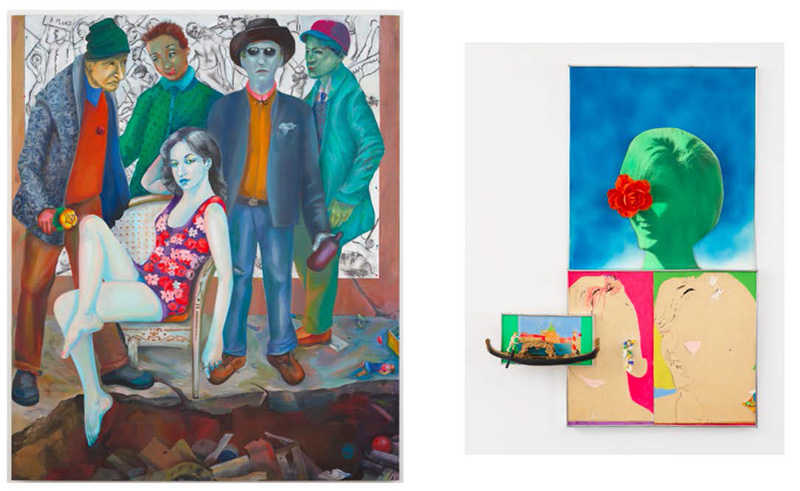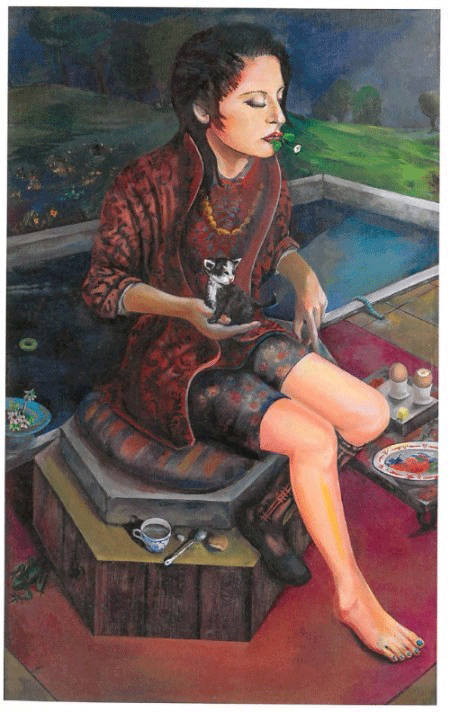ART-PREVIEW:Martial Raysse-Visages
 Martial Raysse is a well known French artist, famous for his distinctive approach in painting and his recognizable imagery. Raysse began to paint and write at the age of 12. After serious studies and an intensive practice of athletics, he decided to dedicate himself to painting at the age of 19. His early works were assemblages which included plastic objects. This appropriation of prefabricated materials led to his association with Nouveau réalisme.
Martial Raysse is a well known French artist, famous for his distinctive approach in painting and his recognizable imagery. Raysse began to paint and write at the age of 12. After serious studies and an intensive practice of athletics, he decided to dedicate himself to painting at the age of 19. His early works were assemblages which included plastic objects. This appropriation of prefabricated materials led to his association with Nouveau réalisme.
By Efi Michalarou
Photo: Lévy Gorvy Gallery Archive
“Visages”, Martial Raysse’s solo exhibition at Lévy Gorvy Gallery in New York, showcases 20 recent paintings, many never before exhibited before. In the exhibition is on show the work “Portrait de Gabriella la jolie vènetienne” (1963) alongside works that date from 2008 to the present. Combining canvases with store-bought trinkets, including a fake rose, a plastic earring, and a miniature gondola, this mixed-media work uses the female face to explore the entwinement of beauty and artifice. Its subjects, two anonymous women whose mouths are frozen in forced smiles, are made nearly unidentifiable through Raysse’s distortion of their images. Shown for the first time, “NOW” and “QUE VEUX TU DIRE MON BEL AMI” (both 2017) are marked by ambiguity and disjuncture. In “NOW” four men each resembling a stock character from painting or literature, stand behind a seductive woman whose legs are alluringly crossed atop a patterned chair. The relationships between these figures is undefined, and each appears detached from the others. Posed before a picture within the picture that pays homage to the sweeping compositions of classical history painting, the scene appears as a suspended moment in a mysterious narrative. “QUE VEUX TU DIRE MON BEL AMI” is characterized by a similar sense of incongruity. Its subject, an androgynous figure dressed in a coat and blazer, balances a blank notebook in one hand and a worm-ridden apple atop the other. Though symbolically suggestive, these objects remain ambiguous, leaving the viewer to wonder at the artist’s intention. “Un beau merle” (2008) features a man, his skin colored green, staring quizzically out at the viewer. “Ces deux gars-là” (2008) pairs two figures. One is clad in a soiled gardener’s hat, while the other sports a laurel wreath topped, inexplicably, with an open can. “Songeuse Roxane” (2013) depicts a young woman against an acid red-and-orange ground. Her expression is haunting and her lips are parted, as if on the verge of speech. Each of these paintings moves between surface appearance and psychic depth, conveying a nuanced range of emotions that are left to viewers’ interpretations. Martial Raysse was born in 1936 and was still very young at the beginning of the New Realism movement in 1960. After a brief formative stint focused on painting, Raysse, together with Arman, Yves Klein, François Dufrêne, Raymond Hains, Daniel Spoerri, Jean Tinguely, Jacques Villeglé and the art critic and philosopher Pierre Restany founded the group Nouveaux Réalistes. The group was later joined by César, Mimmo Rotella, Niki de Saint Phalle and Christo. This group of artists defined themselves as bearing in common a “new perspective approaches of reality”. Drawn to the industrial aesthetic, he created “Hygiène de la vision” (1961-69), a series of works that substantiates the concepts of consumer culture through his assembly of objects made of plexiglas, mirrors, bathroom accessories, neon signs, and advertisements. Nonetheless, Raysse’s participation in the Nouveau Realisme movement was relatively short-lived. In fact, he quickly decided to concentrate on developing a personal style and philosophy in order to give shape to an artistic vision that he could call his own. Looking to push the limits of social norms, Raysse ironically reinterpreted renowned nude paintings of the past. The turning point of Raysse’s career came between 1970 and 1976 when a transformation and evolution of his work came about as a result of internal turmoil, the struggle to reconcile different cultures and accept radical ideological changed, and a desire to escape the constraints of a so-called “traditional” career. This artistic revamping is seen as the cause of the artist’s existential declaration, “A painting is the teaching of freedom. It’s the only vindication of the artist. But what is important today is to change what surrounds us appealing to the need for human coexistence. Some believe that life is to be replicated. Others know that life can be innovative. We shouldn’t quote Rimbaud, but instead live him.” Internationally distinguished from 1962 with the exhibition of Raysse Beach in Amsterdam at the Stedelijk Museum, he represented France at the Venice Biennale in 1966 and 1982. After a period of tireless research of cinematographic techniques, from the 1970s on he dedicated himself again to the figurative applications of painting.
Info: Lévy Gorvy Gallery, 909 Madison Avenue, New York, Duration: 28/2-14/4/18, Days & Hours: Tue-Sat 10:00-18:00, www.levygorvy.com

